
and DANTON BURROUGHS Present |

and DANTON BURROUGHS Present |
|
A Life's Journey Through the Newspapers of the World 1875-1950 A Collection of newspaper clippings and articles from Chicago to Tarzana ~ around the world ~ and back to Encino/Tarzana TARZAN SAYS GOOD-BY TO JANE
|
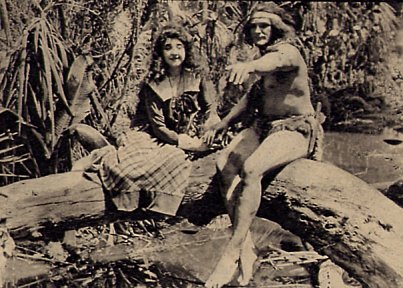
Elmo Lincoln and Enid Markey first played Tarzan and Jane in 1918 |
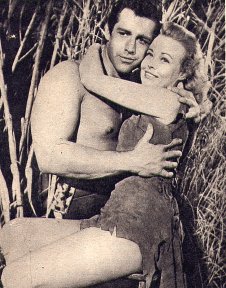
Nerve, rather than beauty or talent, was the test for Jane in 1958 Eve Brent won the part, Gordon Scott was her ape man |
In the steaming jungles of Kenya recently a familiar-looking company of Hollywood performers began work on a familiar motion-picture story in a familiar setting surrounded by a familiar collection of wild animals. Despite all this the first strips of film shot by the cameraman were evidence enough to prove that what was taking place was a cinematic revolution, one that may trigger rude repercussions when the finished product is unreeled soon in Canadian and world-wide movie houses.The significance of the cameraman's work will be gleaned not from what it shows, but what it doesn't show. The film they are shooting in Africa is, of course, another Tarzan story, this one bearing the title of Tarzan the Magnificent. Every red-blooded movie fan knows that Tarzan movies always open with a view of the handsome, mono-syllabic ape man with his pretty English mate, Jane puttering about their idyllic treetop home. In this newest opus, the king of the jungle is in his accustomed perch, but there is no Jane to be found up there in the high branches or even down in the low brush. She hasn't been killed, or treacherously abducted, and she hasn't gone off to see a divorce lawyer. The fact is that after 35 Tarzan pictures and a diverse collection of 20 Janes, the civilized help meet in Tarzan's uncivilized jungle life has been abruptly excised from the script.
"We decided to get rid of Jane so we could give Tarzan more freedom of action," says Sy Weintraub, the dynamic and fast-talking young producer who recently bought out the rights to the Tarzan movies from Sol Lesser Productions. "In this picture we let him get around more and meet different girls (played by Betta St. John and Alexandra Stewart). Without Jane around, we'll be able to bring a little more variety to the Tarzan pictures."
To this end the ape man himself has undergone a minor evolution. "I'm giving the kids a Tarzan they can believe in," says Weintraub. This new concept of a modern, sophisticated muscle man is being tried with handsome ex-cowboy Gordon Scott, now making his fourth film as the screen's current Tarzan. He can talk -- whole sentences; he can think -- fast. "The kids of today want action and adventure," claims Weintraub, "and a bachelor figure is more exciting than a jungle suburbanite swinging home every night to tell his little woman what happened during the day."
There is every possibility that a large percentage of the 140 million-odd people in every continent of the globe who are diehard Tarzan fans, will regard Weintraub's point of view as shocking heresy.
In 42 years, the one thing Tarzan followers have become accustomed to -- and apparently enamored of -- is the lack of change. Always we find Tarzan and Jane enjoying their primitive domesticity, with Jane saying a few intelligible lines in the King's English, and Tarzan mouthing his tried and true dialog of "Me Tarzan, you Jane." Their serenity is then shattered with the noisy arrival of Cheetah, faithful chimpanzee friend and family retainer. Cheetah chatters the news that a white safari is coming. Tarzan grunts that this "means trouble."
The safari is indeed an evil-minded lot. They want to foment a native uprising, steal gold or ivory or ancient statues, engage in gunrunning or maybe even set up a Communist espionage apparatus. During the course of their activities they invariably wreck a native village, kill a few of Tarzan's animal pals, and capture Jane. They may even try to divert Tarzan by getting a slinky siren to flirt with him, but the ape man always brushes her off, beats his chest, trumpets his battle cry, and roars into action. The bad boys are crushed, even though they outnumber Tarzan 10 to one, and wife Jane is carried safely back to the treetop in the last glow of sunset.
This formula has worked well enough to make the Tarzan pictures Hollywood's longest-run hit. Since 1918 the king of the jungle has grossed over $100 million and sold enough popcorn to fill up the Great Lakes. No other film star -- man, woman, or beast -- has ever come close to matching Tarzan's stunning popularity. What's more, there are motion-picture houses which keep running Tarzan films until they disintegrate. This winter some officials from Roosevelt Raceway, New York, toured Europe in quest of harness horseflesh to compete in an international trotting race. One night in Switzerland they dropped into a theatre and saw a Tarzan film which they learned had been made 22 years ago. The house was crowded, too.
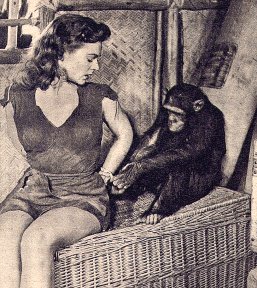
In 1953 Joyce McKenzie played the faithful Jane to Lex Barker's Tarzan No. 10, and Cheetah, of course. |
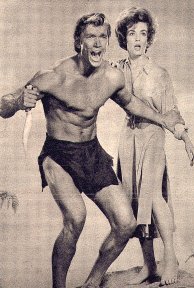
Joanna Barnes, a Boston socialite, will be recorded as the last actress to play Jane - unless audiences force a revival. Dennis Miller was her Tarzan. |
Unless Weintraub is pressured by irate audiences into reviving the character of Jane, Joanna Barnes of Boston will go down in cinema history as the last actress to play this most enduring of all feminine roles. Joanna was the Jane of Tarzan, the Ape Man, which was released early this year and is still playing in many neighbourhoods. She has another distinction besides being the last Jane -- she is also the unlikeliest person anyone could possibly expect to play this role.A graduate of swank Smith college where she was editor of the literary magazine and a Phi Beta Kappa, Joanna comes from a wealthy family and is a debutante well known to the New England social set.
Her first film roles were in pictures like Auntie Mame, where she played a New England snob. Then, suddenly, this brainy beauty switched from clotheshorse drawing-room parts to play the ill-clad (torn skirt, cheap blouse) spouse of an unlettered jungle giant. No studio forced Joanna to play Jane -- she sought out the part herself and got it. "It was a challenge to play it," she says.
"I had no idea the jungle adventures were for real, but I learned soon enough," Joanna points out. Sent out to socialize with the animals, she tried to get friendly with a chimp. He responded by biting her hand. She recovered in a few days and tried to make friends with another chimp. He bit her other hand. Then she was asked to ride an elephant. She obliged and he flung her off his back on to the ground, inducing assorted fresh injuries.
Now that her tenure as Tarzan's mate is behind her, Joanna insists on recalling it as an "exhilarating experience." But would she play another role like that if offered? Her answer was grim and immediate. "Once," she said, "is enough."
Joanna's experience in Tarzan's jungle parallel that of another Jane with brains, Vanessa Brown. A former quiz kid with a genius I.Q., Vanessa played Tarzan's gal in Tarzan and the Slave Girl in 1949. LIke Joanna, she was intrigued with the idea of doing an "athletic part," and intrigued, too, with the notion of showing Hollywood how versatile she was.
Vanessa threw herself into her role with gusto. She climbed trees, swung from branch to branch, and learned to walk a rope. Then one day she slipped off the rope and fell to the ground with a sharp thud. Her mother, a consulting psychologist, ran to her with this cry, "You had to get such good marks in college to do this?"
Over the 42 years Jane has been played by some fine actresses. These include Enid Markey, the original Jane back in 1918; Maureen O'Sullivan, Nancy Kelly, who nearly won an Academy Award with her performance in The Bad Seed, and Vera Miles. Jane has also been played by a number of glamour queens of their day, including Louise Lorraine, Edna Murphy, Natalie Kingston and Brenda Joyce. One Jane, swimming champ Eleanor Holm, made the grade on the basis of her sports page appeal.
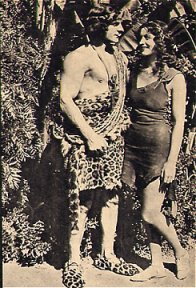
In 1929 Natalie Kingston was mate to ape man Frank Merrill. |
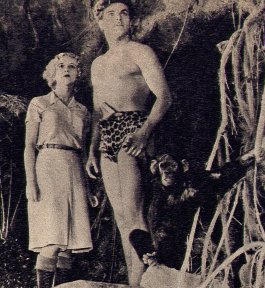
Jacqueline Wells and Buster Crabbe played the pair in 1933. |
Sol Lesser, who produced most of the Tarzan pictures to date established nerve, rather than beauty and talent, as the principal test in his selection of Janes. When a TV performer named Eve Brent was tested for a 1958 Tarzan picture, she didn't flinch when a monkey inflicted a nasty bruise on her hand. Nor did it bother her too much when a veteran boa constrictor was sent gliding across her body as she lay sprawled in a plot of studio jungle grass. "She'll be a perfect Jane!" Lesser exclaimed. And so she was.Lesser had to compromise once when three prospective Janes refused to play in a Tarzan opus which called for them to be offered as human sacrifice to a lion -- and to be placed awfully close to that lion. His fourth choice as Jane agreed to do the part only if a veteran marksman was hired to stand hear her with a loaded elephant gun. Lesser agreed to this only because his shooting schedule had been too long delayed and he was losing money.
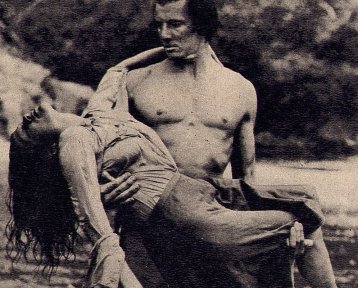
It was Herman Brix's and Uta (sic) Holt's turn to star in 1938. |
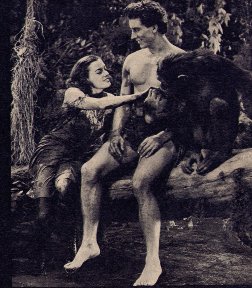
Another '38 Jane was swim star Eleanor Holm, with Glenn Morris. |
Most former Janes point out that the part gave them a good deal of short-term publicity, but had little long-term value, and sometimes hurt their careers. In interviews few like to talk about their jungle picture backgrounds. Some have even gone to the extreme of scratching their performances as Tarzan's mate out of their official biographies."The trouble with being a Jane is that the role types you very badly," points out Maureen O'Sullivan, the most famous of the Janes. "It becomes difficult for you to do more important things in motion pictures."
Maureen played Jane to the Tarzan of Olympic champion Johnny Weissmuller six different times. Her last few performances were made under protest, however. M-G-M, which then held her contract as well as the rights to the Tarzan movies, was reluctant to break up the Weissmuller-O'Sullivan team because of its box-office appeal.
M-G-M became sympathetic to Miss O'Sullivan's pleas, however, after her fifth appearance and decided to write Jane out of the next script by announcing she'd been killed. This so angered Edgar Rice Burroughs, who created Tarzan in a book written in 1912, that he threatened to sue. M-G-M backed down and called off Jane's demise. As a sop to Miss O'Sullivan's feelings, and to give her a chance to wear something more fetching than jungle rags, they moved the locale of the next Tarzan opus to New York. Tarzan fans rebelled and stayed away from the box-office in droves. Tarzan's New York Adventure, made in 1942, remains the only flop to mar the long-run record of this cinematic bonanza.
Burroughs, who wrote 54 (sic) Tarzan novels in all and built up a financial empire out of the movie, radio, comic book and cartoon rights, kept a tight control over Tarzan film scripts until his death in 1950. It was Burroughs who insisted that no liberties be taken wit the film character of the monosyllabic ape man and his ever-loving British mate.
Burroughs always insisted that screen Tarzans and screen Janes exemplify the highest standards of moral conduct. No matter how many female temptresses or male tempters would come around to try to lure them into misbehaviour, it was incumbent upon the two principals never to pay heed to any siren calls. The early Janes not only wore unstylish jungle rags but the kind that covered them so completely no sex appeal was visible. It took a good deal of persuasion before Burroughs would permit later Janes to wear outfits that allowed them to display shapely legs.
Astonishingly enough, however, Tarzan and Jane have been allowed to enjoy 42 years of film love without ever sanctifying their relationship in the rite of marriage (sic). A few years ago a midwestern minister wrote Lesser a letter denouncing him for permitting the king of the jungle and his mate to share a treetop. "In all the years I've been watching Tarzan films I've never seen a marriage ceremony, and I note that Jane shows no wedding ring or marriage certificate," he said. Unless Lesser could offer a satisfactory explanation, the minister said he would denounce the Tarzan films from his pulpit.
Lesser hurriedly pored over every existing Tarzan film script. Sure enough, there had never been a marriage ceremony. He began re-reading all Burroughs' books on Tarzan and found what he was looking for in The Adventures of Tarzan (sic), published in 1913. It described a wedding ceremony between Tarzan and Jane, performed by the captain of a coastal steamer 12 miles outside jungle country.
"Possibly in your great compassion for the ship, which sank with all hands directly after the ceremony, you overlooked the fact that Tarzan and Jane, the only two survivors, had just been married," Lesser wrote the minister. "But lest you still doubt that it actually happened, let me remind you that the ship's log, which recorded the event, was washed ashore, and was picked up by a passing ape friendly to Tarzan and Jane."
Satisfied, the minister let the matter drop. However, the fact remains that Tarzan and Jane were legally married only in the realm of the printed word, and that this marriage was never performed in any screen version of the Tarzan tales.
An official of the firm that distributes the Tarzan pictures told me recently that he may use this as ammunition to answer protests over the termination of the Jane role. "We'll tell the people who write in that we had to get rid of Jane because she persisted in living in sin," he quipped.
Editor's note: Tarzan and Jane were legally married by Jane's father - an ordained minister - in the second Tarzan novel: The Return of Tarzan. The marriage scene described in the article above was probably in the film, The Revenge of Tarzan.
WEB REFS
ERBzine Silver Screen
Guide
The Return of
Tarzan
The Revenge of
Tarzan
e-Text Editions
of the ERB Novels
ERB
and the Press
A Life's Journey Through the Newspapers of the World: 1875-1950

Send
all correspondence to
WEBMASTER:
BILL HILLMAN
ERB
Text, ERB Images and Tarzan® are ©Edgar
Rice Burroughs, Inc. - All Rights Reserved.
Trademarks
JOHN CARTER, WARLORD OF MARS ~ BARSOOM ~ TARZAN
and
all associated characters and their distinctive likenesses are owned by
ERB, Inc.
No
part of this Web site may be reproduced without permission.